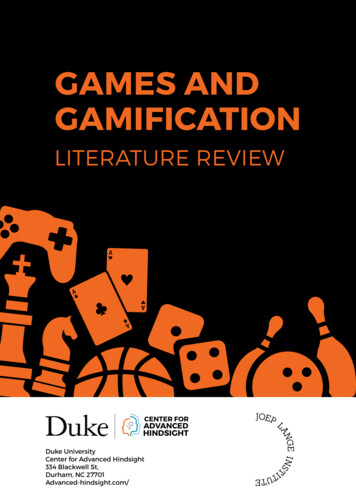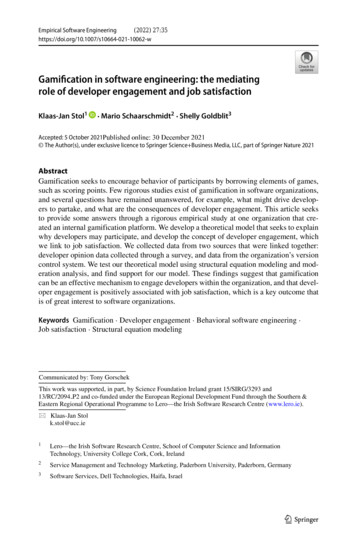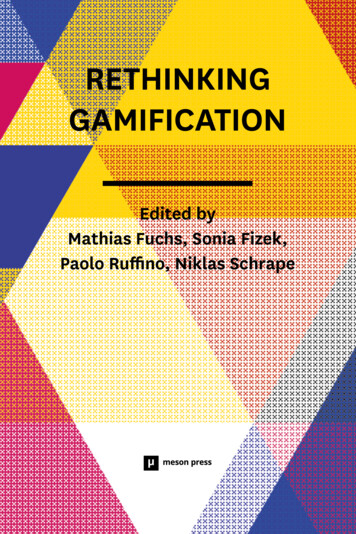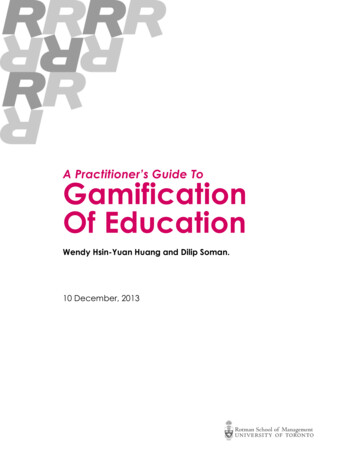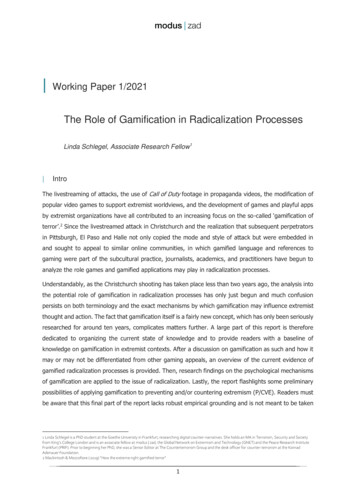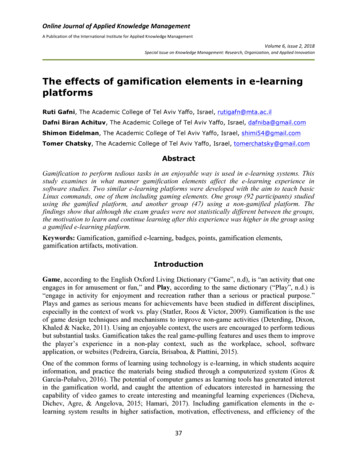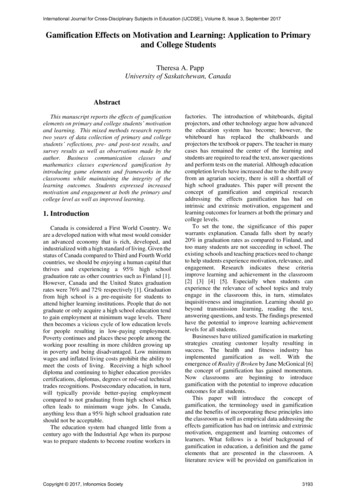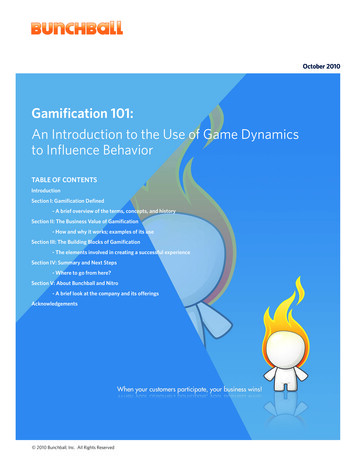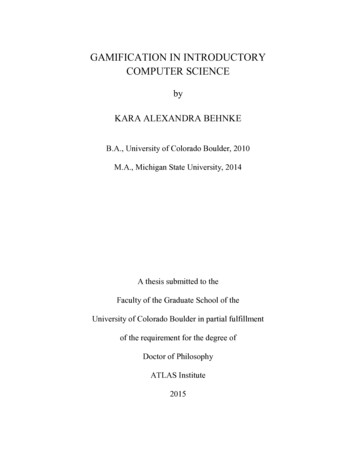
Transcription
1/12/2016AboutA Gamification Framework for Interaction Designers UX MagazineSponsorship & AdvertisingSign In or Register A GamificationFramework forInteraction DesignersGamificationranges ticle No :678 May 24, 2011 by Audrey CraneGamification is a hot topic. Missed it? On Google Trends (http://www.google.com/trends?q gamification&ctab 0&geo all&date ytd) it first appeared as a blip in late October 2010 and then tookoff in January so quickly that it appeared on NPR’s Weekend Edition in vior). Investorsseem interested p‑with‑gamification‑investments‑2/), and italready has a sold‑out conference (http://gsummit.com/) and a fast‑growing list of agencies that willhelp you “do gamification.” You can even join a quest to become a gamification expert(http://gamify.com/experts).As I dove into some reading, a framework emerged that helped me understand gamificationgenerally, and also specifically how (or whether!) to think about it in relationship to projects ework-for-interaction-designers1/22
1/12/2016A Gamification Framework for Interaction Designers UX Magazineworking on at the moment. This framework also helped to put all the examples and criticisms intoa context I could get my head around.Defining GamificationGamification, according to Wikipedia (http://en.wikipedia.org/wiki/Gamification), is:[T]he use of game play mechanics for non‑game applications particularly consumer‑oriented web and mobile sites, in order to encourage people to adopt the applications. Italso strives to encourage users to engage in desired behaviors in connection with theapplications. Gamification works by making technology more engaging, and byencouraging desired behaviors, taking advantage of humans' psychological predispositionto engage in gaming.In other words, make the stuff you’re building engaging so people do what you want, or think aboutways to make them want the same things you want. And this is the breakthrough bit: the stuffyou’re building doesn’t have to be a game to be fun or engaging—anything can be fun or engaging!A Framework for Understanding Degreesof GamificationAs the critics point out, some gamified products are just poorly executed. Just because you sawsomething in a game once doesn’t mean it’ll be fun in your product. But I think that most of thecritics of gamification fail to take into account the wide range of execution that’s possible.Gamification can be applied as a superficial afterthought, or as a useful or even fundamentalintegration. To tease out some differences and to think about how to implement gamification, weat DesignMap have started to put together a framework:1. Cosmetic: adding game‑like visual elements or copy (usually visual design or copy driven)2. Accessory: wedging in easy‑to‑add‑on game elements, such as badges or adjacent products(usually marketing driven)3. Integrated: more subtle, deeply integrated elements like % complete (usually interactiondesign driven)4. Basis: making the entire offering a game (usually product amework-for-interaction-designers2/22
1/12/2016A Gamification Framework for Interaction Designers UX MagazineCosmetic Game ElementsExamples that fall into the cosmetic category abound, especially in shopping, with the use of largephotographs that are reminiscent of the immersive graphics available in popular video games suchas the Call of Duty or Halo series. The purpose of this in games is to immerse the player into abelievable experience. It’s also usually reinforced by creating a story around that experience, andthe two together create an immersive effect that invites the player to engage. In other applications,the result can fall short unless it’s carefully thought through.The Adventure at Altitude (http://www.adventureataltitude.com/) site uses a large photo background itlooks like it could have come right out of Cursed Mountain or n-framework-for-interaction-designers3/22
1/12/2016A Gamification Framework for Interaction Designers UX MagazineUncharted negamification/chrysler.jpg)You could be choosing this Chrysler 300 from the armory of Halo ework-for-interaction-designers4/22
1/12/2016A Gamification Framework for Interaction Designers UX MagazineThe Halo Reach s/cranegamification/pradacomic‑strip.jpg)Almost too right‑on‑the‑nose, the Prada site includes comic stripsThere are also more sites using fun or playful copy. With the recent release of Portal 2, it’s hard notto think of the Portal AI’s promise of ework-for-interaction-designers5/22
1/12/2016A Gamification Framework for Interaction Designers UX MagazineiMeet (https://www.imeet.com/) is dusting your cube, suggests that you take this time to fix your hair,and is warming up the room.Dropbox (http://www.dropbox.com) recommends a Snickers bar.Easter eggs (http://www.eggheaven.com/eggs/) also fall into this category.YouTube's snake Easter eggAccessory Game ElementsGamification in the accessory category is the most common, and draws the most criticism fromthe gaming community for having no value beyond pure marketing pull. Some of the gamificationservices provided by companies such as BigDoor (http://www.bigdoor.com/) and Bunchball(http://www.bunchball.com/) fall into this space. Their services provide explicit rewards such rk-for-interaction-designers6/22
1/12/2016A Gamification Framework for Interaction Designers UX Magazinepoints, levels, and leader status. The fact that external companies can even provide “gamificationsolutions” to other businesses speaks to their fundamental add‑on‑able‑ness.Bunchball addresses a laundry list of gamification "mechanics" and needsOther examples of accessory gamification include tacked‑on game elements such as newsgames(http://newsgames.gatech.edu/) like Huffington Post’s Predict the �news/). Poorly performing leaderboards are poorlyperforming specifically when they’re treated as accessories, and are empty because users aren’tactually motivated to the desired behavior (product reviews in particular seem to suffer from this).Leaderboards that perform well are integrated into the site (see the example in the next category).Integrated Game ElementsGamification in the integrated category is subtler, more thoughtfully integrated, and less explicitthan the other examples we’ve examined so far. Examples include leveraging a sense ofaccomplishment and competition for Backcountry’s ngs/?page 1) (which is deeply integrated an extension of thecompany’s DNA of catering to hard‑core enthusiasts who are passionate about these products),and Amazon’s top -framework-for-interaction-designers7/22
1/12/2016A Gamification Framework for Interaction Designers UX Magazinebackcountry.com (http://backcountry.com)'s leaderboardUnlike cosmetic and accessory game elements, integral elements speak directly several types ofnatural motivations. LinkedIn, Facebook, and Nike use progress meters to entice users onward;the company wants the user to finish, and the progress meters provide a clear visualization of hownear they are to a sense of having achieved completion. Sites such as Gilt Grou (http://gilt.com)pand Daily Candy’s Swirl (http://www.swirl.com), or one‑deal‑at‑a‑time sites like Woot(http://www.woot.com), use scarcity ) and competition todrive behavior.Nike wants you to want to finish designing your ework-for-interaction-designers8/22
1/12/2016A Gamification Framework for Interaction Designers UX MagazineWoot provides detailed information on other purchasesBasis GamificationIn the basis category, activities that weren’t games before have become games. The pleasurepeople get from playing games is layered onto everyday activities.Badge sites fall into this category because the whole premise of simply being somewhere issuddenly a game. Badges from sites such as Foursquare, Gravity, Zaang, and Gowalla are allechoes of the rewards provided in video games. Xbox has “achievements,” and the PlaystationNetwork has “trophies.” Wii Sports has a stamp system, although the famous Nintendo work-for-interaction-designers9/22
1/12/2016A Gamification Framework for Interaction Designers UX Magazinedesigner Shigeru Miyamoto (http://en.wikipedia.org/wiki/Shigeru Miyamoto) says(http://www.gamasutra.com/php‑bin/news index.php?story 23899):I'm not a big fan of using the carrots to motivate people to play. I want people to playbecause they enjoy playing and they want to play more.Many of the products in the basis category address something that might otherwise be less‑than‑fun, such as exercising, saving energy, or donating money. Gamification resonates especially withthese examples, as these solutions try to make things more‑than‑less‑than‑fun. Anyone with kidswill recognize this activity, as we wrack our brains for ways to make brushing teeth or cleaninghouse the most exciting thing anyone could ever aspire to do. Giving to charities becomes moreinteresting and engaging with products such as Free Rice (http://freerice.com/) and Spent(http://playspent.org/). BBC Pinball (http://www.bbc.co.uk/scotland/pinball/) has some interesting ideamanagement s/cranegamification/spent.jpg)Spent supports the development of empathy and requests donations when the game is work-for-interaction-designers10/22
1/12/2016A Gamification Framework for Interaction Designers UX ads/cranegamification/BBC.jpg)BBC Online provides games to help come up with, sort, and prioritize ideasCompetition shows up in this category too, with sites that help improve personal habits such asstickK (http://www.stickk.com/), Skinnyo (http://www.skinnyo.com/), Healthmonth(http://healthmonth.com/), and Welectricity signers11/22
1/12/2016A Gamification Framework for Interaction Designers UX MagazineWelectricity lets users compete against one another and their own goals to reduce energy usePeople can save money by punching the pig (https://www.pncvirtualwallet.com/main.html?s1 0&s2 0) orchasing Mint’s goals ints‑goals‑06302010/), or crossthings off to‑do lists with Rough Underbelly (http://roughunderbelly.com/user/login), or get choresdone with Chore Wars ners12/22
1/12/2016A Gamification Framework for Interaction Designers UX int helps people set up and keep "score" against a goalJane McGonigal is working on saving the world (literally) with her games(http://janemcgonigal.com/play‑me/). A believer in the power of games to motivate, she predicts thatUX designers will become “happiness /uploads/cranegamification/evoke.jpg)Jane McGonigal's EVOKEOther FrameworksAs you’re considering how to build gamification (delight, enticement, and interest) into yourproduct, there are some other guidelines or frameworks to consider:Gabe Zicherman, chairman of at the Gamification Summit, talks about “SAPS”: status, access,power, and stuff. Gabe’s model may be a game‑centric take on Maslow’s broader model(http://en.wikipedia.org/wiki/Maslow%27s hierarchy of needs).In a Mercury News article ��gamification/), Badgevillefounder Kris Duggan identified three large categories of behavior that can be -framework-for-interaction-designers13/22
1/12/2016A Gamification Framework for Interaction Designers UX Magazinethrough gamification: personal achievement, group motivation, and contextualcommunications.One definition of "game" by Roger Caillois (http://en.wikipedia.org/wiki/Game#Roger Caillois) statesthat games must have all of these attributes: fun, separate, uncertain, non‑productive,governed by rules, and fictitious. (It’s interesting to note that most of the examples ofgamification I’ve called out meet some five of the six attributes listed here.)Richard A. Bartle proposed four types of game players (http://www.mud.co.uk/richard/hcds.htm)for MUDs: achiever, explorer, socialiser and imposer (if you’re making personas and thinkingof focusing on gamification, it might make sense to include their “Bartle type”).Nicole Lazzaro (http://www.xeodesign.com/whyweplaygames.html) and Marc LeBlanc(http://8kindsoffun.com/) have different but very interesting models on types of games andplayers.When thinking about building game elements into a product, it becomes important to considera progression of user experience, as opposed to just beginners and experts. See MihalyCsikszentmihalyi’s (http://www.wired.com/wired/topics/4.09/czik pr.html) work and this diagram ofhis concept of “flow.” ��curiosity‑and‑engaging‑education/)Of course Jesse James Garrett’s framework (http://www.jjg.net/elements/) is useful to re‑consider in this context.Hope for Interaction DesignersBefore we pack up and leave the field for the game designers, it’s worth considering what’s reallygoing on in the last two levels of our model, integrated and basis: the enticement of people into anaction to support their own goals within a product. This is the space where interaction design playsnicely, remembering all that we’ve learned from our years of persona the origin of personas.html) and that no one wakes up in themorning hoping to fill out a form that day. Instead, we empathize with people, and remember thatthey have higher goals. We use our skills to create delightful interactions that entice people tomove forward within our sites. This is the stuff we’ve been doing forever. As Vitruvius said (looselytranslated), "Good design has three things: stability, usefulness, and delight." Interactiondesigners are perfectly positioned to start delivering this kind of delight.More Reading“Gamification” returns 847,000 results on Google, but we found some particularly clear, helpful,and super‑smart thinkers if you want to learn a little ework-for-interaction-designers14/22
1/12/2016A Gamification Framework for Interaction Designers UX MagazineStephen Anderson, The Art & Science of Seductive stian Deterding, Just Add Points? ‑games)Dan Saffer, Gaming the Web ��design‑better‑web‑apps)Amy Jo Kim, Beyond Gamification �101‑short‑talk?from ss embed)An interesting example of using a game to facilitate sharing information about road isco‑bay‑bridge‑becomes‑ipad‑game/)About the Author(s)Key topics in this articleAudreyCraneGaming (/topics/gaming)Interaction Design (/topics/interaction‑design)Product design crane)(/contributors/audrey‑crane)Audrey Crane works at ), an interactiondesign firm in San Francisco where she does research, interactiondesign, and design strategy. She's worked in high tech for 15 years,most recently as VP of Design at The Magellan Network, a DesignManager at Dubberly Design Office, and a freelancer.UX Job opportunitiesUX Director ‑ Baltimore or New York, United ated ‑ January 7, 2016Getting started in UXOur contributors and staff recommend these articles onfor developing an understanding of experience designand jumpstarting your career.UX Architect ‑ London, United Kingdom (/uxjobs/river‑island/ux‑architect)River Island ‑ January 6, 2016Hiring the Right Designer (/articles/hiring‑the‑right‑designer)UX Designer ‑ vancouver, CanadaHow Much UX have You Put into Your UX -framework-for-interaction-designers15/22
1/12/2016A Gamification Framework for Interaction Designers UX Magazine(/uxjobs/lululemon/ux‑designer)lululemon ‑ January 5, ��into‑your‑ux‑portfolio)UX Manager ‑ vancouver, Canada(/uxjobs/lululemon/ux‑manager)lululemon ‑ January 5, 2016How Mature is Your Organization when it Comes to ion‑when‑it‑comes‑to‑ux)UX/UI Designer ‑ Los Angeles, CA, United ui‑designer)Chrome River Technologies ‑ January 4, 2016The UX Team Starting Lineup ior UX/UI Designer ‑ Bristol, United ner)Consortia ‑ January 4, 2016UX Designer ‑ Nashua, United se ‑ December 30, 2015Seven Things Your Boss Needs to Know About ��to‑know‑about‑ux)Why UX Designers Need to Think like �to‑think‑like‑architects)Five Customer Experience Lessons Coffee Taught s‑coffee‑taught‑me)Four Things I Learned about UX at Universal out‑ux‑at‑universal‑studios)The (Sometimes) Giddy Experience of Learning nce‑of‑learning‑design)Add new commentLogin via:(/user‑login?destination node/31884%23comments)Your name *E‑mail *The content of this field is kept private and will not be shown publicly.Comment -framework-for-interaction-designers16/22
1/12/2016A Gamification Framework for Interaction Designers UX MagazinePath: pSwitch to plain text editorBecause of problems with spam comments, HTML in comments is not permitted. URLs are allowed, but they will notbe rendered as click‑able links.By submitting this form, you accept the Mollom privacy policy cy).SubmitCommentsgrape seed extract 150 mgJanuary 13, 2014It is able to serve those sustaining benefits of royal jelly from arthritis.grape seed extract 150 mgJanuary 13, 2014Coumarins do the like matter.PropolisJanuary 13, 2014Many charwomen account that Royal Jelly may feature substantial anti‑cancer belongings.PropolisJanuary 13, 2014This is the substance that is fed to all larvae in a amework-for-interaction-designers17/22
1/12/2016A Gamification Framework for Interaction Designers UX Magazinegrape seed extract liquidJanuary 13, 2014refreshing royal jelly has the topper consequences, but it would use up human trial runs to bear this out.Sanjeev KBNovember 27, 2011This article is a good attempt to initiate the UX designers into the world of gamification!June 22, 2011Thanks Theresa!June 14, 2011Thanks for the article. I found it to be a useful introduction to the topic.June 8, 2011Hi Zack, not sure how to reply to your criticism except that I hope for interaction designers just beginning tothink about gamification (along with everything else they're constantly getting or keeping up to speed with),this could be a little helpful in encouraging them to think beyond just shiny stuff or tacking on features.Certainly it's not THE framework, which is why other structures are included here. Gamification, togetherwith related game theory and the psychology of motivation is a HUGE topic that can easily overwhelm (and ispretty humbling to write about). Some kind of simple structure is a nice way to begin to approach it, at leastfor me, and also separate the issues critics are complaining about from the things that are truly useful.To my point in the article, I hope we designers are always thinking about what people want and why, aboutwhat the business wants, and how to align all that in a compelling or even delightful way. For designers withsome experience, this kind of thinking *should* go back to the late 90's with personas and their goals, andshould be part of what they (I) do every day. Gamification just gives us a new perspective on that. Myexperience does extend to stuff that's more typically "gamified", with scores even, but I think that misses ork-for-interaction-designers18/22
1/12/2016A Gamification Framework for Interaction Designers UX Magazinepoint and the power of what's possible with gamification.Finally, if you know Hugh Dubberly then you know that no one knows their sh*t inside and out like he does.Those of us who've worked at DDO are just lucky that he thought we might be able to keep up a little. In anyevent, I'm sorry the article didn't live up to your expectations.June 6, 2011Wow UXMag, this is a poor excuse for an article, let alone a "framework." Disappointed that you took perhapsthe hottest 'trend' in our community and served up this shallow and erroneous article. I have to side with thecriticisms put forth by Bunchball and Fjord here.Audrey, can you tell us what products or services you've applied gamification frameworks to? I'd like to knowwhat your experience is and what your clients ROI was.Dubberly staff usually know their sh*t inside out. This has me truly shaking my head.Zack MazingerDesign StrategyBlast RadiusJune 5, 2011Andrew, the full bleed graphics are just one example of the cosmetic and sometimes "lipstick on a pig"problems that Ian Greenleigh also talks about in his "pitfall" article: http://frc.vc/3g3I'm sure you have clients who ask you for something that looks fun, sexy or like their favorite video game orApple product. It's (hopefully) not the most interesting part of the article, but I'm sure you could add severalexamples yourself of visual/interface treatments that make things look like games and aren't ‑‑ buying aChrysler looks a lot like you're choosing equipment from an armory, the Prada site has another area thatactually has a heads‑up display, etc.May 30, 2011I'm confused as to why you think full screen imagery is gamification on a cosmetic level (The Adventure atAltitude site uses a large photo background it looks like it could have come right out of Cursed Mountain tion-framework-for-interaction-designers19/22
1/12/2016A Gamification Framework for Interaction Designers UX MagazineDoes this mean that before games, full bleed imagery in editorial magazines invented gamificationcosmetics. no. It's a very weak example and as a visual design lead I would suggest that full screen imagesare the only option when trying to communicate the grandeur and scale of mountaineering. Before theinternet wide screen cinema employed as much real estate as possible to convey the scale of a scene, this issimply being translated to web in the example you used. This is not gamification on any level. If anything it'scinematification.Andrew BarkerVisual Design LeadFjordMay 27, 2011Thanks for this thoughtful exploration of the subject, Audrey! I'd agree with Rajat that we (BigDoor) areseeing a broad variety of implementations among our customers and that the narrative underlying each onevaries in depth, and therefore how intricate/integrated the solution appears to be.I'd also argue that some of the examples you cite under "Cosmetic" are actually much deeper expressions ofthe fundamental personality and spirit of the people behind the products themselves, and not strictlyexpressions of gamification. Especially little throwaways like "Grab a Snickers" – they're often subtleexpressions of empathy and whimsy that strengthen people's identification with a product (and often buildtheir confidence in the team behind it).Matt ShobeChief Design Officer, BigDoorMay 25, 2011Hi Rajat, I think there are some important distinctions to be made between the degrees of depth andcompetence, which get at what gamification critics complain about at the top level (and we want to addressthose complaints!), and a fundamental concept at the bottom level. But I don't think it was necessarily fair orreasonable for me to lump in everything that all the gamification service companies provide at one level(never say "always", right?). Would love a demo and will be contacting you offline!Julian, thanks for adding the links. This is a crazy‑huge space now and it's hard to pare down the list, butalways interesting to read more.Rami, I'd recommend reading up on Mihaly Csikszentmihalyi's idea of flow, to your first point. Also note thatgamification doesn't always involve competition, and if thoughtfully implemented takes into account peoplewho are motivated by other things (see Bartle's model of MUD players). Gamification can absolutely be usedfor and perceived as serious business, it just has to be understood as potentially much more than adding ascore. Here's an interesting (though competitive) offline "serious business" ramework-for-interaction-designers20/22
1/12/2016A Gamification Framework for Interaction Designers UX lse‑works‑try‑thisMay 25, 2011Hi,I still have a lot of doubt regarding gameifiction:1‑it may punish late comer, imagine there is social network give people points upon their participation, andyou sign up to find all your connections has 5000 points and you start with zero, it will lets user feel he is notbelong to this place or he is under achiever.2‑it effects the quality of content generated, imagine you give points based on each task user achieve, orquestion he answer, user will posts low quality and spam like contents, just to gain points.3‑ it increase tension between users, what you would feel if you are inside the elevator with stranger and bothof you know he will get point if he exit the elevator first!!!4‑ It will push away serious, business users; you will not like your client to see your passion with collectingpoints over the application.I think the only success example of gamefiction until now is the progress bar and trying to push it more thanthat in serious or business app will fail.ThanksRami Khalil@ramikh81May 24, 2011I feel that you can't really tackle this subject without referring to Daniel Cook over athttp://www.lostgarden.com/. It's exactly what he's been doing for years, and he's an astonishing speakerand writer.See for yourself:Wordcamp 2010: Why we turned Microsoft Office into a 2010‑why‑we‑turned‑microsoft.htmlRibbon Hero turns learning Office into a ro‑turns‑learning‑office‑into.htmlWhat actitivies can be turned into ding fun into your software ramework-for-interaction-designers21/22
1/12/2016A Gamification Framework for Interaction Designers UX ously, his blog is heavily recommended reading.May 24, 2011Hi Audrey ‑I don't really understand your categories. Cosmetic is pretty straightforward. After that there's really onlyone category ‑ "integrated" ‑ with varying levels of depth and competence.Our customers are using our platform to implement everything from simple badging systems, to salesincentive programs, to full‑fledged loyalty programs for TV shows. Ping me and I'd be happy to give you ademo.btw ‑ before starting Bunchball I worked in Interaction Design at IDEO and was in the HCI program atStanford, so it's great to see interaction designers start to pay attention to gamification!best, ‑ rajatrajat ‑[at]‑ tion-framework-for-interaction-designers22/22
Gamification can be applied as a superficial afterthought, or as a useful or even fundamental integration. To tease out some differences and to think about how to implement gamification, we at DesignMap have started to put together a framework: 1. Cosmetic: adding game‑like visual el
